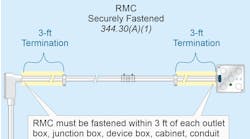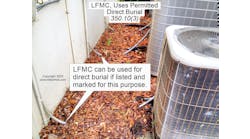Stumped By the Code? GFCI Protection for Branch-Circuit Receptacles in Locations Other Than Dwelling Units
Q. What are the NEC requirements for GFCI protection for branch-circuit receptacles in locations other than dwelling units?
A. GFCI protection is required for all 125V through 250V receptacles supplied by single-phase branch circuits rated 150V or less to ground, 50A or less, and all receptacles supplied by 3-phase branch circuits rated 150V or less to ground, 100A or less, installed in the following locations [Sec. 210.8(B)].
(1) Bathroom Areas. GFCI protection is required for all receptacles located in bathroom areas.
According to Art. 100, a “Bathroom Area” is an area that includes a basin as well as one or more of the following: a toilet, urinal, tub, shower, bidet, or similar plumbing fixture.
(2) Kitchens. GFCI protection is required for all receptacles located in kitchens or areas with a sink and permanent provisions for either food preparation or cooking.
The NEC does not give clear guidance, but since list item Sec. 210.8(B)(5) already covers receptacles within 6 ft of the sink, this rule serves to cover receptacles beyond that distance but still within the “area” containing a sink and provisions for food preparation or cooking.
(3) Rooftops. GFCI protection is required for all receptacles located on rooftops.
For example, a 15A or 20A, 125V receptacle outlet must be installed within 25 ft of heating, air‑conditioning, and refrigeration equipment [Sec. 210.63].
Rooftop GFCI receptacles are only required to be readily accessible from the rooftop itself [Sec. 210.8(B)(3) Exception].
(4) Outdoors. GFCI protection is required for all receptacles located outdoors.
(5) Sinks. GFCI protection is required for all receptacles located within 6 ft from the top inside edge of the bowl of a sink.
(6) Indoor Damp and Wet Locations. GFCI protection is required for all receptacles located in indoor damp and wet locations.
(7) Locker Rooms. GFCI protection is required for receptacles located in locker rooms with showering facilities.
(8) Garages and Similar Areas. GFCI protection is required for all receptacles located in garages, accessory buildings, service bays, and similar areas.
According to Art. 100, a “Garage” is a building or portion of a building in which one or more self-propelled vehicles can be kept for use, sale, storage, rental, repair, exhibition, or demonstration.
(9) Crawl Spaces. GFCI protection is required for all receptacles located in crawl spaces at or below grade level.
(10) Unfinished Areas of Basements. GFCI protection is required for all receptacles located in the unfinished areas of a basement.
(11) Laundry Areas. GFCI protection is required for all receptacles located in the laundry area.
(12) Bathtubs and Shower Stalls. GFCI protection is required for all receptacles installed within 6 ft of the outside edge of the bathtub or shower stall not installed in a bathroom as defined in Art. 100.
This addition is to cover receptacles installed within 6 ft from bathtubs or shower stalls that are not covered by one of the other list items. In non-dwelling occupancies, the hazard is related to the tub and shower, not to where they may be physically located within the building. A hydromassage unit might be in the corner of a physical therapy room for example.
Q. What are the NEC branch-circuit rating requirements for individual appliances?
A. (A) Individual Circuits [Sec. 422.10]. The branch-circuit ampere rating for an individual appliance is not permitted to be less than the branch-circuit rating marked on the appliance [Sec. 110.3(B)]. The branch-circuit rating for motor-operated appliances must be in accordance with Sec. 430.6(A) and Sec. 430.22. A branch-circuit for an appliance that is a continuous load must be rated not less than 125% of the marked ampere rating of the appliance [Sec. 210.19(A)(1)].
Let’s run through an example scenario based on these requirements.
Example: What is the calculated load for conductor sizing for a 4,500W, 240V water heater?
Solution: I = P ÷ E = 4,500W ÷ 240V = 18.75A
Conductor Sizing = 18.75A × 125% = 23.44A
Answer: 10 AWG conductor [Table 310.15(B)(16)]
Branch circuits for household ranges and cooking appliances can be sized in accordance with Table 220.55 and Sec. 210.19(A)(3).
(B) Circuits Supplying Two or More Loads [Sec. 422.10(B)]. Branch circuits supplying appliances and other loads must be sized in accordance with the following:
• Cord-and plug-connected equipment must not be rated more than 80% of the branch-circuit ampere rating [Sec. 210.23(A)(1)].
• Equipment fastened in place must not be rated more than 50% of the branch-circuit ampere rating if the circuit supplies both luminaires and receptacles [Sec. 210.23(A)(2)].
These materials are provided to us by Mike Holt Enterprises in Leesburg, Fla. To view Code training materials offered by this company, visit www.mikeholt.com/code.





